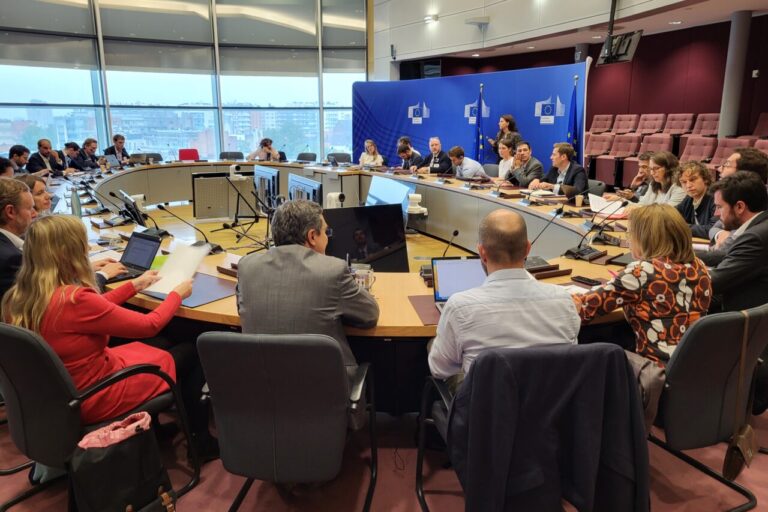The recent passage of the Inflation Reduction Act (IRA) signals a changing tide in global climate engagement and asserts the US as a leader in climate mitigation. The bill – the single largest climate investment in US history – leverages 369 billion dollars to scale clean energy production, develop climate innovation technologies, create jobs, and reduce pollution in disadvantaged communities. The IRA integrates climate considerations into the bedrock of the US domestic and foreign policy agenda for decades to come, unlocking new investments in durable climate solutions that will have a transformational impact on our global climate system. It also creates space for a new age of global cooperation on climate to emerge, particularly as the implementation of the IRA will begin in the lead-up to COP27.
While the IRA is a significant first step in helping the US meet its climate and energy goals, for it to be effective, we must also pursue new opportunities to scale up clean energy infrastructure, while decarbonising typically carbon-intensive sectors. Doing so means leveraging the policies outlined in the Infrastructure Investment and Jobs Act (IIJA) and CHIPS and Science Act (CHIPS), and complementing them with regulatory reforms that actually allow the country to build, following the examples of Sweden, Germany, and Denmark, which have been highly successful in scaling their clean energy infrastructure and decarbonising across sectors.
What We’ve Won
Thanks to years of research and development in collaboration with the private sector, the US has been adept at innovating power generation technologies over the past few decades. Where the country falls short, however, is in building out transmission systems to deliver energy where it needs to go, deploying carbon removal technologies at the scale demanded by the Intergovernmental Panel on Climate Change to tackle current and past emissions, and scaling our manufacturing capacity to produce climate innovation technologies like solar panels, wind turbines, direct-air-capture hubs, and batteries.
The Biden Administration’s actions on climate thus far look to tackle these challenges, with the IIJA, CHIPS, and IRA each delivering unique opportunities to decarbonise the US economy across sectors and deliver unprecedented innovations in climate infrastructure and technology.
Where IIJA makes critical inroads in restoring dated infrastructure and CHIPS marks a resurgence of industrial policy, IRA sits at the intersection of both, offering incentives for transitioning to a clean energy economy for consumers and companies alike. Investment is just one tranche of the pie, however. To unlock the full potential of these investments, the United States must adapt its regulatory and permitting framework to build out the clean energy infrastructure supercharged by these bills quickly and efficiently.
Constructing a path toward clean energy
For many years, the US climate movement unified behind our goal of passing federal climate legislation, which we’ve now done. But in the wake of this victory, fissures once brushed under the rug are coming to the fore. In the 1960s and ‘70s, the environmental movement found success aligning itself around what we opposed. It was enough to have a legal and policy strategy solely oriented toward making it harder for industry to do bad things like polluting our air and water. We must now align ourselves around making it easier to build massive amounts of clean energy infrastructure.
We can learn from our partners in Europe about how to build more efficiently. The EU and US face similar challenges to expanding clean energy infrastructure. In both the US and EU, the averaging permitting times for energy projects like solar, offshore wind, and transmission lines can exceed 10 years. The EU, however, is taking notable steps to address this by directing EU member states to identify “renewable go-to areas” where clean energy projects can receive permits within a year; engaging communities early and often in the project development process; and establishing biannual monitoring, reporting, and review protocols for permitting. The US should follow the EU’s lead by expediting the permitting process for clean and renewable energy to make a carbon-free future our reality.
What the data shows
Action on climate change has major electoral implications as well, particularly as the US midterm elections approach. Data for Progress polling shows that the IRA has broad support among the electorate. We even find that nearly two-thirds of voters (64 per cent) of voters say they would be more likely to vote for a candidate who supports the bill.

Furthermore, the IRA’s climate and clean energy provisions in particular are extremely popular with voters across party lines.

Beyond highlighting the popularity of specific climate investments, the messaging of these bills is critical as well. Our data shows that messages focused on climate change mitigation as a pathway to economic security and short-term economic benefits, like lower energy prices and good jobs, are most effective with voters. Communicating most effectively about climate change is vital to continue building support for climate investments.
A new era of climate politics
The past year of legislative action has led to what some have called a “mini-golden age” of climate policy in the US. It took us decades to get here, but no longer is the US demanding more from others than it is willing to do as a country. However, the fight has just begun. We are entering a new era of climate politics, defined not by what we oppose, but by what we build. To ensure make the IIJA, CHIPS, and IRA’s full emissions reduction potentials reality, the climate movement must reckon with what the next phase of climate advocacy looks like. We fought for federal investments and won – now we must actually deploy those dollars to projects and grants across the country. This will require a productive conversation about how to quickly and efficiently build out clean energy infrastructure. We look forward to a new vision for the environmental movement where we continue to improve air and water quality, provide Americans with affordable energy, and do what it takes to decarbonise.
This article is published in cooperation with the Green European Journal.
It has been shortened to be accommodated on our blog. For the full version please visit: www.greeneuropeanjournal.eu







